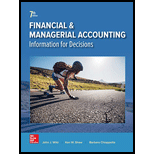
Concept explainers
Current assets: Current assets are a type of asset, which can change into cash and cash equivalent within a reasonable timeframe of one year.
Long-term investments: Any investment that company makes with a view of keeping it for more than one year is called Long-term investments.
Plant Assets: Any assets whose useful life is more than one year and which is use to facilitate the production process is called plant assets.
Intangible assets: Intangible assets do not have any form, they cannot be seen and they cannot be touch but yet they have value. For example: Patent and
Current Liabilities: Any liability which needs to be paid within one year is called current liability.
Long-term liabilities: Any liability which is not due to be paid within one year is called long- term liability.
Equity: The Company needs finance to run the business. Equity is one of the methods through which company raise the capital.
To identify: Correct letter against each
Want to see the full answer?
Check out a sample textbook solution
Chapter 3 Solutions
Financial and Managerial Accounting
- I am searching for the correct answer to this general accounting problem with proper accounting rules.arrow_forwardYou are posting questions and giving unhelpful i am also positing you can give my answer i will not give unhelpful but If you unhelpful my answer then I will unhelpful your answer. Also you know unhelpful will remove after coureshero review. So coperate.arrow_forwardWhat is the average price paid by the stockholders for a share of common stock ?arrow_forward

 AccountingAccountingISBN:9781337272094Author:WARREN, Carl S., Reeve, James M., Duchac, Jonathan E.Publisher:Cengage Learning,
AccountingAccountingISBN:9781337272094Author:WARREN, Carl S., Reeve, James M., Duchac, Jonathan E.Publisher:Cengage Learning, Accounting Information SystemsAccountingISBN:9781337619202Author:Hall, James A.Publisher:Cengage Learning,
Accounting Information SystemsAccountingISBN:9781337619202Author:Hall, James A.Publisher:Cengage Learning, Horngren's Cost Accounting: A Managerial Emphasis...AccountingISBN:9780134475585Author:Srikant M. Datar, Madhav V. RajanPublisher:PEARSON
Horngren's Cost Accounting: A Managerial Emphasis...AccountingISBN:9780134475585Author:Srikant M. Datar, Madhav V. RajanPublisher:PEARSON Intermediate AccountingAccountingISBN:9781259722660Author:J. David Spiceland, Mark W. Nelson, Wayne M ThomasPublisher:McGraw-Hill Education
Intermediate AccountingAccountingISBN:9781259722660Author:J. David Spiceland, Mark W. Nelson, Wayne M ThomasPublisher:McGraw-Hill Education Financial and Managerial AccountingAccountingISBN:9781259726705Author:John J Wild, Ken W. Shaw, Barbara Chiappetta Fundamental Accounting PrinciplesPublisher:McGraw-Hill Education
Financial and Managerial AccountingAccountingISBN:9781259726705Author:John J Wild, Ken W. Shaw, Barbara Chiappetta Fundamental Accounting PrinciplesPublisher:McGraw-Hill Education





